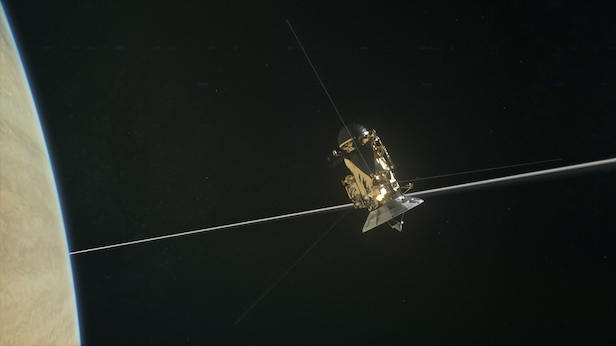Cassini finds ‘surprisingly empty’ gap in Saturn’s ring
As the spacecraft plunges through the gap between the gas giant and its rings, mission members are shocked by the latest finding

This artist’s impression shows Cassini diving into the gap between Saturn and its rings. Image credit: NASA/JPL-Caltech
As NASA’s Cassini spacecraft passes through the gap between Saturn and its rings, the mission is ready for the hustle and bustle of icy rocks and dust. However, recent results have revealed that one of the gaps is surprisingly empty.
“The region between the rings and Saturn is ‘the big empty’ apparently,” says Cassini Project Manager Earl Maize of NASA’s Jet Propulsion Laboratory (JPL) in Pasadena, California. The Cassini spacecraft is coming to its ‘Grand Finale’, scheduled for 15 September, and will consist of 22 dives through Saturn’s rings that will eventually end with the spacecraft crashing through the gas giant’s atmosphere. On the 26 April, the spacecraft began its first dive into the unknown and, as scientists held their breath, the Radio and Plasma Wave Subsystem (RPWS) collected first-of-its-kind data on the gap between Saturn and its rings.
NASA’s scientists were expecting an area covered in ice and dust. With this in mind, the scientists positioned the spacecraft in such a way that upon entry into the gap, its main antenna acts as a shield to protect Cassini’s more delicate instruments. It wasn’t until 27 April, that the data collected by Cassini was sent to the spacecraft’s team members. As audio files were transmitted back to Earth, astronomers were expecting to hear several pings and pops, as ice would hit the antenna of the RPWS. This is expected because as the spacecraft passed through the ring plain outside of the main rings earlier in its mission, it caught hundreds of ring particle hits per second. But that isn’t the case with the gap, as William Kurth, RPWS team lead at the University of Iowa, Iowa City, explains: “It was a bit disorienting – we weren’t hearing what we expected to hear, I’ve listened to our data from the first dive several times and I can probably count on my hands the number of dust particle impacts I hear.”
This strange observation baffled many, but it has also made scientists more eager to gather more exciting data ahead of the Grand Finale. The reason why this area between Saturn and its rings is so empty is unclear, but while everyone awaits the second plunge on 2 May, the team at JPL will be busy understanding the data collected.
Maize concludes: “Cassini will stay on course, while the scientists work on the mystery of why the dust level is much lower than expected.”
Keep up to date with the latest space news in All About Space – available every month for just £4.99. Alternatively you can subscribe here for a fraction of the price!




